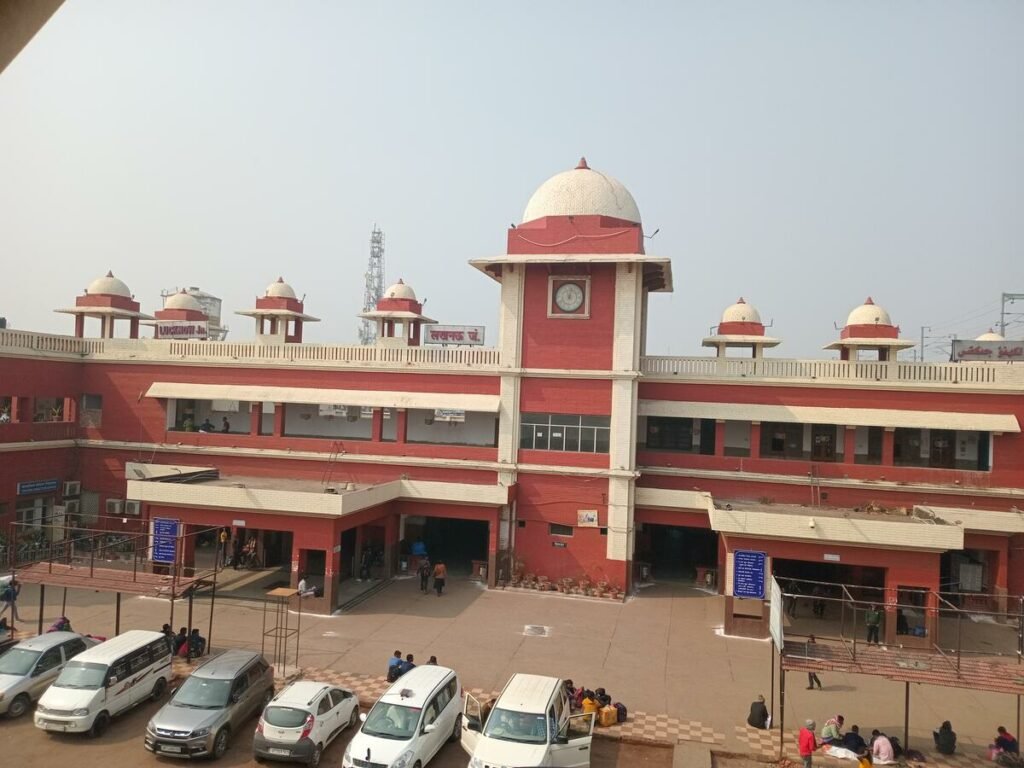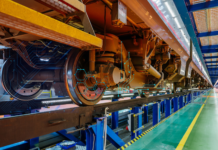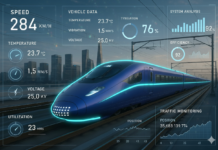Lucknow, the capital of Uttar Pradesh is a multicultural city located at the northwestern bank of the Gomti River. Lucknow is adjacent to rural towns and districts, making it a central hub in the Indus-Gangetic Plain. The city majorly covers an area of 2,528 square kilometres . Historically referred to as the “City of Nawabs,” Lucknow’s significance was elevated in 1528 when it came under the control of Babur, the founding Mughal emperor.
Lucknow serves as a critical centre for various industries, including education, commerce, pharmaceuticals, and technology.
The city is covered with numerous railway stations in different parts. The major long- distance railway station is Lucknow railway station situated at Charbagh.
Kanpur, a major industrial city located in the central-western region of Uttar Pradesh, is recognised as the financial capital of the state. Often referred to as the “Manchester of the East,” Kanpur is prominent for its colonial architecture, well-maintained gardens, and distinctive local dialect. The city is also a key centre for IT parks and is renowned for producing high-quality leather, plastic, and textile products. The city is the crucial financial and industrial base of North India, snuggled on the banks of the Ganga River.
As per the 2011 census, Lucknow ranks as the eleventh most populous city in India, while Kanpur is the 12th most populous city. In Uttar Pradesh, Kanpur is the most populous city, followed by Lucknow in the second position. Both cities feature a dense railway network.
Glimpse of Suburban Railways

In India, urban rail transit is a crucial component of intra-city transportation, particularly in densely populated metropolitan areas.

Suburban rail networks play an essential role in the public transportation systems of many major Indian cities. They are vital for commuters, offering an efficient and reliable mode of transportation. By linking suburban towns and peripheral areas to central urban zones, where employment opportunities are concentrated, suburban rail systems provide passengers with a fast and comfortable alternative to road-based transportation. As a result, they are widely regarded as a preferable option for reducing car dependency and alleviating urban congestion.

Inception and Early History of Lucknow-Kanpur Suburban Railway
To enhance connectivity between Uttar Pradesh’s administrative capital, Lucknow, and its economic and industrial capital, Kanpur, the Lucknow-Kanpur Suburban Railway was inaugurated on 23 April 1867.
Originally developed and operated by the Indian Branch Railway Company, the line later became part of the Oudh and Rohilkhand Railway network.
Currently, the operations of the Lucknow-Kanpur Suburban Rail Line are jointly managed by Northern Railway, North Central Railway, and North Eastern Railway.
Route & Stations
The Lucknow-Kanpur Suburban Railway line (formerly known Cawnpore-Lucknow line), spans approximately 72 kilometres (about 45 miles) between Lucknow Junction and Kanpur Central. This critical connection facilitates efficient travel between the two cities, serving as a backbone for daily commuters.
Travel Time and Train Services
The journey from Lucknow Junction to Kanpur Central typically takes between 1 hour 15 minutes and 1 hour 50 minutes, depending on the type of train service. The Shatabdi Express is the fastest, covering the distance in approximately 1 hour 15 minutes, while other intercity trains complete the journey in around 1 hour 30 minutes.
Shared Track Operations
The suburban services are not operated on dedicated tracks; instead, they share tracks with long-distance trains.
The stations along the Lucknow-Kanpur Suburban Railway routes are: Lucknow Junction, Amausi, Piparsand, Harauni, Jaitipur, Kusumbhi, Ajgain, Sonik, Unnao Junction, Magarwara, Kanpur Bridge Left Bank, Kanpur Central.
Rolling Stock
The Lucknow-Kanpur Suburban Railway predominantly utilises Electric Multiple Unit (EMU) and Mainline Electric Multiple Unit (MEMU) trains, ensuring efficient and reliable service for commuters.
EMU and MEMU Trains
Electric Multiple Units (EMU) and Mainline Electric Multiple Units (MEMU) are self-propelled train systems widely used in India for suburban and regional rail services. Both systems are electrically powered, eliminating the need for separate locomotives and offering a more environmentally friendly alternative to diesel-powered trains.
Electric Multiple Units (EMU)
EMU trains are designed for shorter, high-frequency routes, particularly in urban and suburban areas. They operate using electric traction motors integrated within the carriages, allowing for a distributed power system across multiple coaches.
Mainline Electric Multiple Units (MEMU)
MEMUs are designed to cover longer distances than EMUs and are designed to operate on mainlines. They are mainly employed to serve rural and semi-urban areas.
| Track length | 72 km |
| Track gauge | 5 ft 6 (1,676mm) Indian gauge |
| Electrification | 25 kV 50 Hz AC overhead catenary |
Benefits of Lucknow Kanpur Suburban Railways
Efficient Commuter Connectivity
The Lucknow-Kanpur Suburban Railway provides a reliable and efficient mode of transportation for daily commuters. This efficiency makes it a crucial link for individuals travelling for work, education, or other daily needs.
Economic Growth
By enhancing accessibility between Lucknow, the administrative capital, and Kanpur, the industrial capital, the suburban railway plays a major role in supporting economic activities. It facilitates the smooth movement of workers from the corner of the city, which not only increases employment opportunities but also promotes the economic growth of the city.
Reduction in Traffic Congestion
By providing a viable alternative to road transport, the suburban railway helps alleviate traffic congestion on major highways and urban roads. This not only reduces travel times but also contributes to lower pollution levels.
Environment friendly
Lucknow-Kanpur suburban railways employ EMU and MEMU trains which are more environment friendly as they are fueled by electricity. This reduces the carbon footprints as compared to roads, contributing to a more sustainable urban transport system.
Integration with Other Transport Modes
The suburban railway complements other public transport systems, including the Lucknow and Kanpur metro networks. This integration creates a cohesive and efficient transport system, enhancing overall mobility and accessibility for residents across the two cities.
Support for Urbanisation
As urban areas continue to expand, the suburban railway serves as a critical infrastructure component in managing this growth. It provides a structured and sustainable public transport option that supports orderly urbanisation and reduces the environmental impact of increased urban density.
Cost-Effective Travel
The suburban railway offers an affordable and practical transportation solution for a large number of daily commuters. Compared to private vehicles or taxis, it provides a cost-effective alternative, which makes it accessible to a broader population.
Challenges faced by Lucknow Kanpur Suburban Railways
Absence of dedicated tracks
The Lucknow-Kanpur suburban railways don’t have dedicated tracks. It shares tracks with long-distance trains which leads to overcrowding and delays. This absence of dedicated tracks affects the operation frequency of suburban trains which results in reduced commuter satisfaction and also increases the risk of accidents.
Deteriorating Infrastructure
Most of the amenities and rolling stocks are deteriorating, which can result in periodic malfunctions and service intervention. Modernizing the infrastructure is crucial for enhancing safety and dependability.
Capacity Constraints
The existing train services are not sufficient to handle peak-hour demand, leading to overcrowding and discomfort for passengers.
Funding and Investment
Adequate funding is crucial for the upgradation of existing infrastructure. Limited funding prevents the implementation of the required improvements.
Technological Advancement
Keeping up with technological advancements in railway operations, signaling, and safety systems is essential. The lack of modern technology affects the operational efficiency of suburban trains.
Conclusion
Being one of the oldest suburban rail networks, Lucknow Kanpur Suburban Railways is a vital commuter rail service owned by Indian Railways. This suburban rail system not only strengthens the economic ties between Lucknow and Kanpur but also plays a pivotal role in reducing traffic congestion, supporting urbanisation, and promoting environmentally sustainable transportation. However, challenges such as the absence of dedicated tracks, deteriorating infrastructure, and capacity constraints pose hurdles to its optimal functioning.
To fully utilise the potential of this suburban rail line, it is imperative that ongoing efforts focus on infrastructure modernisation, technological upgrades, and securing adequate funding for enhancements.
By addressing these challenges, the Lucknow-Kanpur Suburban Railway can continue to serve as a backbone for regional development, offering a cost-effective, efficient, and sustainable transportation solution for the growing urban population. As cities expand and the demand for reliable public transport rises, the importance of this suburban railway will only increase, making its development a priority for future growth and prosperity in the region.






